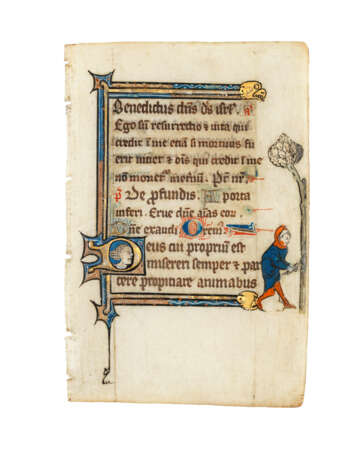ID 870802
Lot 9 | Anonymous Flemish illuminator
Estimate value
£ 2 000 – 3 000
A leaf from the Ghistelles Hours, in Latin, illuminated manuscript on vellum [south-western Flanders, c.1300]
A delightful decorated leaf from one of the earliest Flemish Books of Hours; the calendar for the Ghistelles Hours, now at the Walters Art Museum, Baltimore, dates the parent manuscript to the end of the 13th century.
120 x 80mm. Historiated initial 'D' opening the Collect at the end of the Office of the Dead ('Deus cui proprium est miserere[...]'), 11 lines, text block: c.61 x 47mm, three-quarter bar-border terminating in animal heads, the historiated initial with a woman's face in profile and a marginal figure, a man chopping a tree with an axe (the gold a little rubbed, small pigment losses and light surface soiling).
Provenance:
(1) The calendar for the dismembered Ghistelles Hours (Walters W.851), written in French, contains an Easter Table for the years 1300–1316, indicating that the manuscript was probably written between Easter 1299 and Easter 1301. It lists saints venerated across south-west Flanders and markets held each year in Bruges, St Trond, Lille and Messime. The first owner of these Hours has traditionally been proposed as John III Ghistelles (d.1315), Lord of Ghistelles and Ingelmunster, but the small size of the parent manuscript and the depiction of aristocratic ladies on leaves including our own have prompted suggestions that it was made for a female family member.
(2) Heinrich Eisemann (1890-1972): leaves from the already fragmentary volume, identified by Rosy Schilling as having once belonged to Sir Sydney Cockerell, were sold by Heinrich Eisemann in the 1950s and are now dispersed in public and private collections. M. Manion et al. listed many of the sister leaves in Medieval and Renaissance Manuscripts in New Zealand Collections, 1989, no 72.
(3) Sotheby's, 2 December 2003, lot 12 (sold with two sister leaves).
(4) Sotheby's, 23 May 2017, lot 9 (the aforementioned sister leaves were lots 8 and 10).
Special notice
This lot has been imported from outside of the UK for sale and placed under the Temporary Admission regime. Import VAT is payable at 5% on the hammer price. VAT at 20% will be added to the buyer’s premium but will not be shown separately on our invoice.
| Place of origin: | Belgium, Western Europe, France, Europe |
|---|---|
| Auction house category: | Medieval & renaissance manuscripts |
| Place of origin: | Belgium, Western Europe, France, Europe |
|---|---|
| Auction house category: | Medieval & renaissance manuscripts |
| Address of auction |
CHRISTIE'S 8 King Street, St. James's SW1Y 6QT London United Kingdom | |
|---|---|---|
| Preview |
| |
| Phone | +44 (0)20 7839 9060 | |
| Buyer Premium | see on Website | |
| Conditions of purchase | Conditions of purchase |




